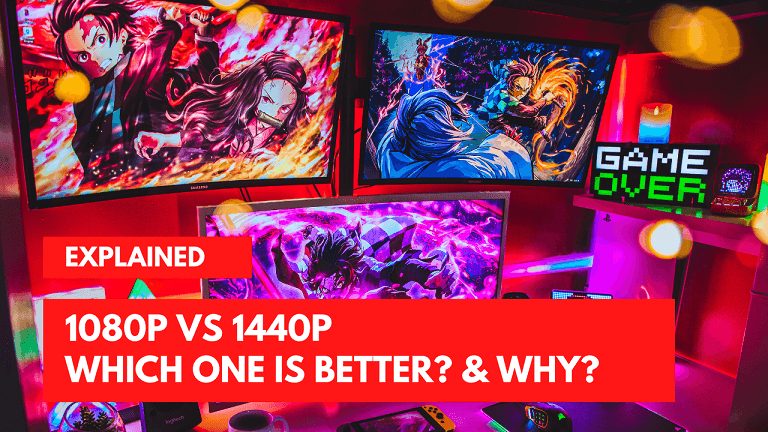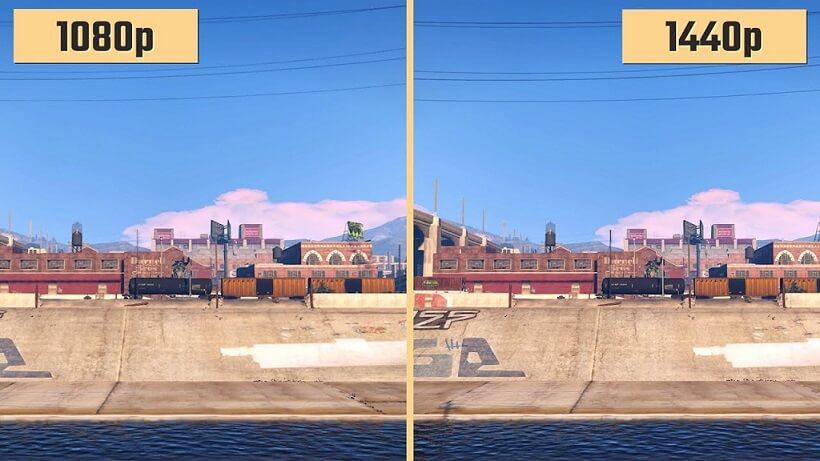Welcome to our detailed guide on 1080p vs 1440p which is better? and why?
When deciding on a TV or monitor we look for resolution, clarity, and all the works.
Basically, all the things that make the TV or Monitor viewing experience great or which enhance the overall experience.
A monitor or TV with 1080p is a resolution of 1920×1080 which means that the width of the screen is 1920 pixels while on the other hand, the height of the screen is 1080 pixels. The total resulting pixels sum up to 2,073,600 on-screen pixels. It is also called Full HD or FHD.
1440p is also called Quad HD or QHD which is a very high-definition resolution that is just between Full HD and 4K. Some also refer to it as Wide Quad High Definition (WQHD).
Its display resolution measures 2560 pixels in width and 1440 pixels in height. 1440p resolution is quite often known as 2K resolution.

1080p vs 1440p: Which One Is Better? & Why?
As we all know, the higher the pixels better the picture quality and that is a reason why in any debate of 1080p VS 1440p, 1440p resolution most probably will win.
| Criteria | 1080p Monitor | 1440p Monitor |
| Screen Resolution | 1920×1080 | 2560×1440 |
| Image Quality | Good | Better |
| Pixel Density | Lower | Higher |
| Display Resolution | Full HD (FHD) | Quad HD (QHD) |
| Screen Size | Smaller screens (e.g., laptops) | Larger screens (e.g., 27-inch monitors) |
| Screen Real Estate | Less space on taskbar and icons | More space on taskbar and icons |
| Graphics Card | Less pressure on GPU | More demanding on GPU |
| Storage Space | Requires less | Requires more |
| Refresh Rate | Higher rate | May put more pressure on graphics card |
| Picture Quality | Good | Sharper and more accurate images |
| Competitive Gaming | Lower resolution is suitable | Higher resolution for sharper images |
| Native Resolution | Standard resolution for TVs | Sought-after resolution for gaming and mobile |
| Gaming Experience | Lower resolution, smoother gameplay | Higher resolution, sharper images |
| Frame Rate | Higher frame rates possible | May affect performance in demanding games |
| Productivity | Limited workspace | More screen real estate for multitasking |
| Aspect Ratio | Standard aspect ratio | Higher resolution, wider aspect ratio |
| Video Editing | Adequate for basic editing tasks | Provides more detail and clarity |
| Readability | Easier to read text | Smaller writing, may be more difficult to read |
| Screen Distance | Less noticeable difference | More noticeable difference on larger screens |
| Price | Generally more affordable | May be more expensive |
More the number of pixels the better the picture quality which results in sharper and more accurate images.
1. 1440p Display
1440p resolution has twice the number of pixels as compared to 1080p.
Devices with 1440p resolution are only 1.77 times smoother than 1080p and give a clearer picture. The question is whether the just extra smooth image is worth the switch for you or getting that new device with 1440p resolution.
1440p resolution is usually found in laptops and is the most sought-after computer gaming resolution. In recent times many gaming consoles companies have entered into 1440p resolution for their gaming works.
We have also published on guide on 1440p 144hz monitors, these are the best budget-friendly monitors that offer a great 4k gaming experience.
1440p resolution is again quite commonly found in mobile phones and is quite popular and provided for by many mobile phone companies. The reason for its popularity is that on smaller screens it increases the pixel density by a huge margin and greatly improves the picture quality for the user.
Many camera users only opt for 1440p, this could again be mainly that most cameras in recent times come in 1440p resolution only. So, for people who are into videography or photography, 1440p resolution is the most ideal.
2. 1080p Display
1080p resolution is usually found in HD TVs mostly which are 40 inches in size or bigger.
Most 40-inch TVs or bigger TVs usually start at 1080p resolution and are considered standard resolution. It is also found in online streaming services, video games, and smartphones.
1080p vs 1440p: Size Plays Very Important Role
Let’s see which resolution would be ideal for gaming. While gaming we need less input lag, high response time, and high refresh rate. We need the images to be sharp with a high refresh rate & monitors FPS.
In that case, 1440p is much better than 1080p as it will allow you for sharper images and a better gaming experience. This again is dependent upon your screen size.
1440p resolution for gaming would be ideal for a 27-inch or more monitor size. Opting for a 1440p resolution for gaming you would have to check for things like the refresh rate and whether your monitor can handle the additional load and gaming at 1440p.
Gaming at 1440p would put more pressure on your graphics card since they would be working on more pixels and unfortunately your performance may get affected which will leave you with a frame rate as low as 1080p.

When switching from different screens like a smaller to a bigger screen with the same resolution it is important to keep in mind that the number of pixels on the screen remains the same irrespective of the screen size and only the number of pixels-per-inch changes.
Switching from 1080p to 1440p resolution is a change and on most occasions is a noticeable change but that all depends upon your screen size.
The bigger the screen the more noticeable the change is.
For a laptop screen a few feet away from you the change might be noticeable and appreciable but for a TV screen that is at quite a distance, the difference might not be that noticeable unless and until your screen size is increased by quite a margin.
Making your videos look clearer or your photos look sharper is not the sole reason why 1440p resolution is optimal.
On smaller screens, 1440p resolution increases the picture quality of smaller less noticeable icons which would otherwise look blurry on other resolutions.
On much smaller screens, 1440p resolution gives a defined look to icons and other smaller items on the screen which would look blurry or less enhanced in 1080p resolution.
All in all, for small screens, 1440p resolution is the most ideal.
A con with 1440p is that it might make reading things on the screen a little more difficult.
Since many pixels are put together in 1440p, the writing may appear smaller than what you might find in a device with 1080p
On the other side of it all, 1080p resolution devices give a better refresh rate, they require less storage space, and less pressure falls on the CPU and processors.
It also provides better support to other hardware.
Conclusion
1440p provides for a larger workspace, which results in a lot more space on the Windows taskbar and for the other icons on the desktop as well.
Since there is a larger workspace, surfing and going through the internet is a much more seamless task as more information gets displayed to us.
If one is opting for a monitor less than 27 inches then a 1080p resolution would be the most ideal.
If you’re opting for a monitor that is more than 27 inches then 1440p resolution is the way to go. But one should also consider the other aspects mentioned above.
If given the chance of choosing between the same model with different resolutions, one should opt for the one with the higher resolutions.
